The recent surge of Voynich research interest in Diebold Lauber’s workshop has come about thanks to Koen Gheuen’s research. Koen’s focus was on the series of drawings in the centre of Voynich Manuscript’s zodiac roundels: and he began by tracing the unusual hand-clasping going on in the Voynich Gemini roundel (which I discussed here previously):
The similarity Koen highlighted between the Voynich Gemini roundel figures and the two frontmost figures in the following drawing from Diebold Lauber’s workshop is striking:
The parallels between the Voynich zodiac roundels and elements in Diebold Lauber’s workshop’s output are both qualitatively and quantitatively striking, not least of which is the crayfish (also highlighted by Koen) which – to the best of our collective knowledge – only appears misdrawn in a particular way (with the crayfish’s legs incorrectly attached to its tail rather than to its body) (a) in a Lauber-illustrated Buch der Natur, and (b) in the Voynich Manuscript’s Cancer zodiac roundel.
Knotty Problems
But there are problems of historical logic to untangle here. The first problem concerns the arms: the two hand-clasping Voynich Gemini figures have their arms crossed over (which is a correct depiction of the medieval ceremony), whereas the figures in Lauber’s drawing (dated 1448-1450) do not have their arms crossed over (which is incorrect). Koen dug up an image from the Werkstatt von 1418 (a different manuscript workshop, but from the same general area) that he suggests might well have been a predecessor to one or both of the other two:
Here, we can see the arms crossed over (which is correct) and a simple neckline (which is the same as we see in the Voynich Gemini roundel). Yet the arms are uncrossed, which is what we see in the Lauber drawing.
Koen proposes that this would make it difficult for the Voynich Gemini figures to have been derived from the Werkstatt von 1418 image, because the arms there were uncrossed, and it would be a little bit odd for the arms to have been recrossed.
Yet at the same time, given that the image depicts a man and a monk, this too is problematic for anyone trying to trace out a line of direct transmission.
It seems likely to me that the plain necklines depicted in all the Voynich roundel drawings that include a clothed human neck are systematic copies of a series of zodiac roundels from a single predecessor German manuscript (which was most likely a calendar). So we can tentatively date the predecessor document as being, say, closer to 1420-1430 (the date of the Werkstatt von 1418 drawing) than to 1448-1450 (the date of the Diebold Lauber drawing).
This gives us, I suspect, a sequence tree something broadly like this:
However, is this lineage compatible with the strangely misdrawn crayfish, which seems to suggest that Lauber’s workshop was somehow involved?
All I can say is that it is possible that the unknown document on the right (that I suspect was the predecessor for both the Voynich Gemini and the 1448-1450 Diebold Lauber drawing) was also from the Diebold Lauber workshop. The earliest known Lauber document is dated 1427 (Köln, Hist. Archiv der Stadt, Best. 7010 (W) 251, signed “Diebold de Dachstein”), and a number of Lauber’s early illustrations may have been by Hans Ott (whose work, the Heidelberg site says, can be found in Strasbourg documents between 1427 and 1449).
I (eventually) managed to track down some drawings from this 1427 Lauber document:
And yes, there are certainly a fair few simple necklines there. So the proposed sequence is still entirely possible, I think. Unless you know better? 🙂
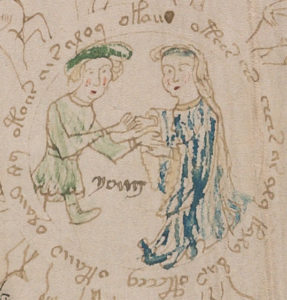
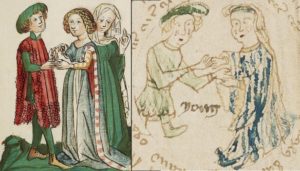
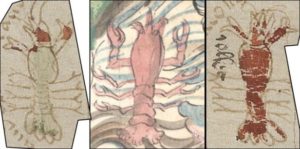
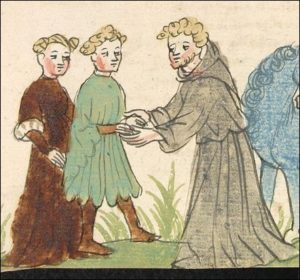
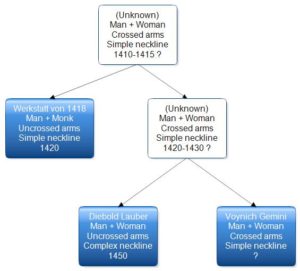
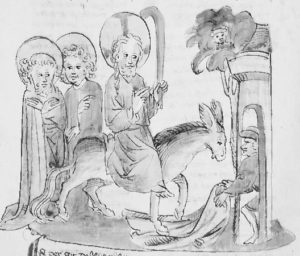
Nick: Some basic questions:
Can we be confident that these kinds of drawings were from only a small number of workshops and were not more widespread?
What can we say about the likely distribution of such drawings?
For example is it likely that such manuscripts would have been distributed widely over Europe reaching Spain or Russia or Turkey? Alternatively can we say that the author must have seen such a manuscript within the broad vicinity of Western German? In which archives were these manuscripts that you/Koen have dug up found and can we guess that that manuscript remained in the area?
In short do these serve in any useful way as geographical markers. For example I doubt these made their way to China or the Americas and so might imply a European origin for the manuscript, but can we be more specific?
If they don’t serve as useful geographical markers what are we hoping to find, a block-paradigm or enough to construct a block-paradigm?
I assume nobody is suggesting the manuscript was produced by one or other of these workshops.
Don’t get me wrong, I am sure it has value. I would imagine someone or some people need to scour the archives for similar drawings and more broadly assess the extent of the production these kind of drawings by date and who may be some of the workshops producing similar drawings. I do think research into the geographical distribution of such manuscripts could be useful.
Nick: your scheme is more or less what I had in mind when I wrote about these images, though I would shift some dates. As you know I think 1400-1430 is the most likely date range for the source.
My question is though, why would you insist on involving Lauber? As far as I understand, there was a continuous activity of cheap mass production of manuscripts in Haguenau since the early 15th century. Granted, it’s nice to be able to use a name of a historical figure, but I don’t understand why this is necessary if people were doing exactly the same thing in his home town while Lauber was still wearing diapers.
Mark: personally I see two scenarios. One is common ancestry. Two is that someone used the facilities at the Haguenau shop to do his own thing. This included models and pigments; some manuscripts by the earlier workshop use very similar colors to those of the VM.
The Haguenau style is similar but still different from the VM. Also they generally used paper. That is why I prefer to invoke Okham here and keep it on common ancestry.
On the other hand, I must stress that it’s hard to find examples that match on so many levels. Believe me, I tried. If you find better examples I would love to see them
Most of my comments would be subjective, and I’ll leave them out, or at least for later. My main doubt is the following.
How can we distinguish which of the following two options is more likely:
A) The Voynich MS zodiac illustrations were copied from several sources
B) Someone else created a zodiac cycle from several sources and the Voynich MS was copied from this result.
I don’t think we have any concrete indication, and all we can say is that option A is more simple.
Another question is more for Koen: it has been suggested that in some Lauber manuscript(s) there are clothes of the style between 1400-1430, but I don’t remember seeing them. Is it possible to point them out?
Koen: I tried to make it clear that because your “freak show” crayfish appears only in Lauber and the Voynich, we currently have no reason to think it was from anywhere but Lauber’s workshop – and we know that Lauber’s workshop also made at least one calendar. Lauber was commercially active from at least 1427 (and may well have been active before that date, we have no idea when he was born), so I don’t see why you think he was wearing metaphoric diapers.
As to the paper/vellum thing: we’re talking about a predecessor manuscript here with a man + woman Gemini with round necklines and a deformed crayfish Cancer roundel, I’m not suggesting for a moment that Lauber’s workshop had anything to do with the Voynich Manuscript beyond creating a calendar (probably) that was used as a source for the Voynich’s zodiac roundels. It’s a copy.
Supposing our VM illustrator just happened, God forbid, to have come from a later period than circa.1421. Had they then unwittingly chosen to re-configurate, inaccurately detailed appendage, of an earlier period, on their Cancer t. crustacean, that could well have given the game away. As the saying goes, ‘When serving crawfish bisque be sure to use a wooden ladle’
Koen or Nick.
I should like to know the event being depicted by the ‘man and monk’ illustration. Since the gesture is one that can represent a warm welcome in general or a betrothal in particular, I wonder if image shows a young man about to enter a religious order? (dedication to religious order was often described as a betrothal to the church or to Christ).
Nick: ah yes, I understand. There is evidence that a faulty lobster model circulated in Alsace, rather than it being “caused” by Lauber. I will attempt to make a blog post about this today (I need to show pictures so can’t do in the comments).
Meanwhile, here’s another early Lauber for you:
https://www.voynich.ninja/thread-2205-post-23582.html#pid23582
Rene: I had made a note about Lauber without any specific manuscripts, probably based on someone’s suggestion in the forum thread. I need to check this when I have more time. It would make sense if it turns out that Lauber did in fact not use this fashion, since the picture would only become cleaner. Even by the late 1420’s, when Lauber became active, the style was on the decline in manuscript art.
Koen: the round neck I showed was from the 1427 Lauber manuscript. 🙂
Koen: It seems that common ancestry makes most sense as you suggest. So it would seem to me that the author of the Voynich used one or more related sources within this common ancestry, assuming as you say that this form of representation is not widespread.
However what can we say about where the author might have seen one of these sources? Were these manuscripts almost exclusively only of interest to people in Western Germany or did these manuscripts become popular far and wide?
“The first problem concerns the arms: the two hand-clasping Voynich Gemini figures have their arms crossed over (which is a correct depiction of the medieval ceremony), whereas the figures in Lauber’s drawing (dated 1448-1450)
[ DO NOT]
have their arms crossed over (which is incorrect).”
Bracketed addon from me.
So there’s some anomalies in the Zodiac drawings. What a surprise !!
I’m still stuck on the unusual choice of fish for Pisces.
Rene: one could point out that the zodiac clothing necklines are all the same, which might serve to make them more likely to have come from a single source. Beyond that, we’re not doing well for systematic evidence, I’d agree. :-/
Diane: direct link to monk page here: https://digi.ub.uni-heidelberg.de/diglit/cpg323/0563/image
According to the description, the gesture is one of saying goodbye.
The main reason why I included this image in the post was to show how the earlier Willehalm showed a closer similarity in dress to the VM figure. Note especially the way the bottom has been drawn. On the other hand, the Lauber version has a closer similarity in pose *and* the correct hat. This might suggest that another Willehalm MS (older than the Lauber one) contained the permutation we are looking for.
Mark: all I can say with some certainty is that there is a close connection between the Alsatian worshops’ stock and the VM Zodiac images. But they may both have been based on an “international” example since the clothing style of the VM figures belongs to the international gothic. Theoretically, an exemplar (or family of exemplars) could have come from Italy, Germany, France, the Netherlands, even England. Further research is required 🙂
Basel lies at the Southern end of Alsace. I believe they have very large archives. I have not found the time to explore those online archives, but I wonder if others have. As anyone who has read my comments would know Basel is a place of some significance to me. In fact in my mind it has assumed a greater significance as if the author spent a considerable time at the Council of Basel in a somewhat junior capacity he/she would have had plenty of time to study manuscripts held there. So if there is any truth in my theory then documents from there might be expected to have some similarity to some of what we see in the Voynich. Obviously manuscripts would have been dispersed since then, but there might be a link there.
One thing I find interesting about my theory is that it does predict Northern Italian and Germanic influences on the manuscript, yet Germanic influences on the manuscript were something that I never considered when forming my theory.
Jim: thanks for the correction, it was (as you guessed) a typo introduced during editing. *sigh*
Koen: your menorah match is very cool, and I look forward to your upcoming faulty Alsace lobster post. 😉
After reading Lauber’s text, I also noticed something.
There could also be a connection to the VM in the spelling, not only in the pictures.
I’ve never seen that in German the Latin abbreviation for ( et ) was also used as a suffix. Nice to see the mirrored 5 in (kom5, = coming) (myn5= mine) and so on.
I am more than astonished, because the author of the VM does the same.
Is there a connection in the training ?
While reading it also seems to me as if he is writing in Bernese dialect. The name Lauber would also suit the Bernese environment.
I must admit Alsatian lobster is starting to sound rather nice, even if it appears to be a somewhat mutant variety. I have been to Alsace and enjoyed the food, but never had lobster, though given that Alsace is inland maybe that is not surprising.
Koen,
for your reply ( November 21, 2018 at 3:09 pm) many thanks indeed.
Just by chance (almost) I ran into this lobster for cancer with a similar anatomical issue:
http://ica.themorgan.org/manuscript/page/56/77039
It almost seems as if things like disconnected anatomical extremities and out of alignment leaf formations may have had something to do with deity taboos for which some license was allowed for artistic reproduction. Crayfish must have been part of the common diet in advanced European societies of the middle ages, yet time and again the visual records are misrepresented as if deliberate. What gives?..
The exception that comes to mind is that Jews were not into crayfish, as part of their Kosher obligations. So those of that faith who strayed to the east where such creatures were not known, may have portrayed them to the unknowing natives of those regions, as we see them depicted in their art.
I’ve seen Cancer depicted in medieval European mss as everything from a lobster, to a crayfish, to prawns and then to things similar to our freshwater ‘yabbies’ (Cherax destructor) and even to things which look more like a fat lady-bird (lady-bug in American) – gone wrong. In the days before refrigeration I don’t think you’d need to go far inland before the only crustaceans the majority knew at first hand lived in fresh water, but that’s a guess.
Dinner is served: https://wp.me/p7iZLi-3vB
Nick: On the basis of what I have read in your post I don’t feel we can conclude that the Voynich dates from after 1420. It is plausible. In fact my own theory dates the Voynich to the early 1430s, so a post 1420 dating of the manuscript is music to my ears as someone working within the 1404-1438 carbon dating(it effectively cuts this range in half). However, I don’t leap on ideas, like this dating, that would fit with my own theory as I have been accused of with regard to null words.
It is true that the Gemini drawing does look very similar and Koen’s research sounds interesting though I have not studied it, but I would be interested in a stronger argument for the post 1420 dating; I appreciate that your post is brief by necessity, so there may be a more fully fleshed out argument that you haven’t presented.